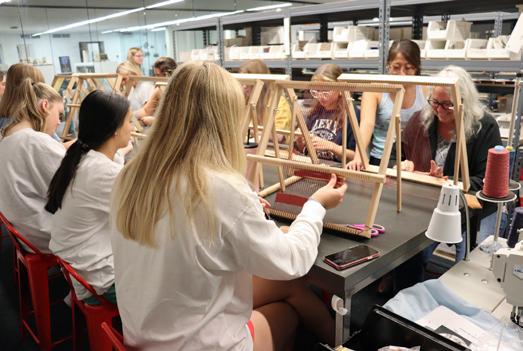
2 minute read
GRANT TRANSFORMS MATERIALS LAB
A grant from the Angelo Donghia Foundation is transforming the Materials Lab of the Fay Jones School from a traditional materials library into a teaching, making and research workshop that’s on par with other labs and shops in the school.
The $46,700 grant is the latest in a series of awards to the Department of Interior Architecture and Design from the Donghia Foundation, a non-profit organization that promotes design education. In total, the school has received more than $215,000 in grants and student scholarships over the past seven years.
Advertisement
“The sustained support our students and faculty have received from the Donghia Foundation is remarkable,” said Carl Matthews, professor and head of the Department of Interior Architecture and Design. “It speaks to the high quality and nationally competitive nature of the work we are doing in the department.”
Between 2015 and 2019, four interior design students in the school were each recognized with a $30,000 Senior Student Scholarship Award, which is the largest, most prestigious award within interior design education. In 2021, the foundation awarded the school a $49,000 grant to explore the potential benefits of using virtual reality technology in design education.
This latest grant allows its principal investigators, Jennifer Webb, Kim Furlong and Lynn Fitzpatrick, to purchase weaving looms, a printmaking press, a color testing booth and artificial lighting stations, as well as expand access to digital material databases for all interior architecture and design studios.
The program will also incorporate virtual reality (VR) technology purchased through the previous Donghia Foundation grant. Materials will be uploaded into the VR program, allowing students to experience their designs.
Merging VR with the traditional method of creating materials will help overcome the disjunction between physical materials and how they are portrayed digitally, Fitzpatrick, a teaching associate professor, said.
“We are hoping to get students more interested in the actual making of materials,” she said. “Getting them to think more about specifying their own materials as opposed to going and getting just everything off the shelf.”
Students who develop this knowledge and skill base early in their education adapt more organically to this method of learning in their advanced-level courses, said Webb, assistant dean of graduate studies and an associate professor. She said these practices can start to not only inform the design process within studios but also can influence the entire curriculum.
“Where you’re really creating from the inspiration, from the concept, then your work is going to be different from everybody else’s work,” Webb said. “That’s a good thing for your portfolio and in your practice, a way to fulfill your individual design intentions.”
This grant allows the program to unite traditional methods of making with modern VR technology, providing students with a unique experience, Fitzpatrick said.
“One of the things that’s most exciting about this grant opportunity is that we get to work from both ends, from the very hands-on to the sort of newer high-tech,” she said. “I think that clients as well as firms appreciate both.”
With this grant, the program will also bring more focus to lighting and its effects on materials. This will help students bridge the gap between their lighting design and materials courses.
“They’re looking not only at daylighting effects on materials, but actual artificial light effects on materials, which often falls into the interior designer’s realm,” Furlong, an associate professor, said.
Increasing the hands-on approach of the Materials Lab, which recently relocated to a larger space in Vol Walker Hall, will help interior architecture and design students develop a more well-rounded set of skills that will set them apart, Fitzpatrick said.
“It elevates the Materials Lab and turns it into something that is less passive and more active,” she said.










